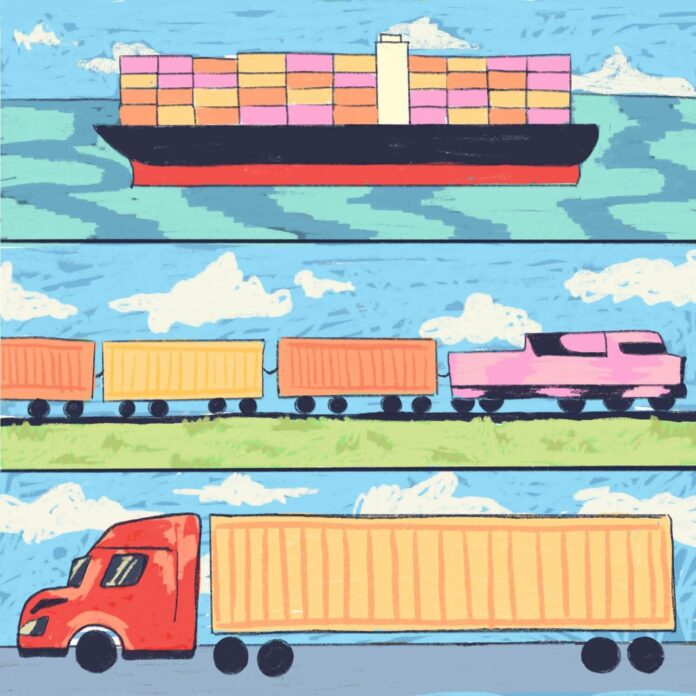Your clothes were probably made in Bangladesh, and your shoes in Vietnam. Your phone was probably assembled in China, and its processor was probably made in South Korea or Taiwan. Your morning coffee beans were probably grown in Brazil, and your car might have been imported from Japan. It’s hard to see and appreciate it, but despite living in America, we are creatures of the entire world.
The modern world is no accident — there are volumes to be written about trade treaties and the political fights over protectionism. But this story isn’t about that. This is a story about how a ruthlessly efficient trucking magnate, desperate political salvos in the wake of an oil crisis and one of the most underrated American presidents created our modern standard of living.
In mid-to-late 2021, we heard about supply chain problems in the wake of the COVID-19 pandemic, with accompanying visuals of ships backed up, full of containers with the goods demanded by a newly opened American economy, and ports working overtime to clear the backlog. However, this situation could have been so, so much worse, if not for containerization.
The movie “On The Waterfront“ depicts the life of ports in the early 1900s — strong longshoremen would maneuver the various goods that were to be shipped across the country, and carefully handle and process the goods that arrived at ports. The lives of longshoremen were centered around the waterfront — and perhaps most importantly of all — shipping was labor intensive and inefficient. Dozens of longshoremen and weeks of time were necessary to load and unload ships at ports, and even more were essential in handling the customs and warehousing of these goods. There were neither shipping containers nor cranes back then.
The creator of the modern shipping container, Malcom McLean, didn’t work in overseas shipping, but rather in overland trucking. As someone who was always in pursuit of a competitive edge and willing to take bold bets, he decided to implement a decades-old idea — putting goods to be shipped in boxes that moved from truck to ship and back — and integrate it into his trucking business.
McLean repurposed a World War II-era tanker ship, loaded it up with custom shipping containers at Port Elizabeth in New Jersey and the ship set sail for Houston in 1956. In the years that followed, containerization of shipping swept across the globe — and the “20 foot equivalent unit,” for the 8.5×8.5×20 foot container, defined global shipping.
Of course, shipping to ports isn’t the entire story of transportation, and most freight needs to travel in trucks and trains before reaching Target or Walmart. However, until the late 1970s, freight rail was one of the most protected industries. The Interstate Commerce Commission (ICC), originally established in 1887 for the purpose of restraining railroads, was quickly taken over by the railroads who used it to stop competition and restrict the ability to innovate.
The ICC also controlled entry and pricing in the trucking industry, requiring that for-hire trucking companies obtain permission to run any route. However, this meant that trucking companies were often forced to burn excess fuel, and were virtually immune from competition thanks to the ICC’s restrictions on entry as well as the restrictions the ICC placed on freight rail shipping. Just as with railroads, the controls on pricing and entry were used to keep rates high for trucking, not to benefit consumers.
However, when the 1970s arrived, inflation ran high and Middle Eastern countries imposed an embargo on oil, and popular opinion turned against the ICC and its practices that kept prices high and burnt excess fuel. In this political climate, deregulation — the lifting of restrictions on entry and price — was in the air, and the Democratic party under Jimmy Carter felt it was necessary to bring down prices and tame inflation.
Building on earlier deregulation efforts by presidents Nixon and Ford, Carter signed the Motor Carrier Act in July 1980, getting rid of entry restrictions in the trucking industry, and in October, the Staggers Rail Act, which did the same for freight rail. Though the immediate effects weren’t apparent, the laws yielded significant positive results we’re living with today. Trucking became faster and cheaper, freight rail saw massive increases in investment and safety improvements, and shipping containers moved ever faster from ship to train to truck and back.
Though there are disasters and struggles with our transport system, such as the aforementioned port backlogs or the derailment in East Palestine, Ohio, it is important to understand that the current system, while not perfect, is the culmination of over 60 years of improvements. We should pinpoint issues — such as inadequate safety inspections — and remedy them, but at the same time it is vital to appreciate the complex transportation ecosystem we see now. The abundance and interconnectedness enabled by fast, efficient, and competitive shipping is truly miraculous, and should be built upon, not thrown out.
Contact Avinash Iyer at iyera@oxy.edu.
![]()



































